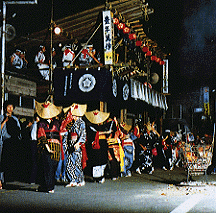Buddhist Services


The purpose of Buddhism is to help us achieve a clear, direct state of mind in which suffering can find no place to take root.
Since this state does not depend on anything outside ourselves, no place or date is any more "religious" than any other. Times and locations of services are a matter of convenience, tradition and need.
In India, Shakyamuni Buddha achieved his serene, unbiased perception of reality without any Buddhist writings or rituals to help him. So Buddhist services are not "sacraments." They are not absolutely necessary to the attainment of peace of mind. But why turn down anything that can help us?
Buddhist services have five functions.
Different schools of Buddhism use different images. Through
these, we pay respect to the qualities exhibited by certain
historical figures such as Shakyamuni, or to certain
characteristics of Enlightenment, such as this Kuan Yin, a
personification of compassion.
For example, one of the most popular practices the Buddha taught for laymen involves picturing Enlightenment as a place. The famous raked sand gardens in Japanese Zen temples were depictions of this "pure land." The Buddha who lives in this land, Amida Buddha, is, in part, a personification of reality before we start emphasizing some parts, ignoring others, stuffing it into categories, and generally doing to life what cheap white bread does to wheat. By acting out expressions of reliance and gratitude toward Amida, we prepare ourselves emotionally to accept and work with reality.
 In almost all temples and in many homes where rice is eaten, the
first serving of rice of the day is placed in a small container
before the statue of the Buddha. In some homes, the first fruit
of the harvest or any gift received will be placed before the
image for a while. This builds up associations of appreciation
and gratitude.
In almost all temples and in many homes where rice is eaten, the
first serving of rice of the day is placed in a small container
before the statue of the Buddha. In some homes, the first fruit
of the harvest or any gift received will be placed before the
image for a while. This builds up associations of appreciation
and gratitude.
Flowers and candles are usually used in the Temple1s altar or the home shrine. Besides the practice of an attitude, these, because they wilt or burn down, are also reminders of the impermanence of all things. Because of this, many families prefer not to use artificial flowers or electric lights. Others, trying to develop more compassion, prefer artificial or potted plants, as a way to avoid killing flowers by cutting them. Whatever best expresses gratitude and reliance to you is correct for you.
In India, people greeted one another by placing their palms together. This gesture spread along with Buddhism and is now used as a greeting between Buddhists. In services, we use this gesture to greet the image of the Buddha as we enter or leave and at certain significant points in the service. Depending on the traditions of each group, it can be accompanied by a simple bending at the waist, or it can be a very involved bow touching the forehead to the floor. It can be done once or repeated a set number of times.
Bringing small gifts of money or goods to the Temple is not only a gesture of gratitude and an aid in supporting Temple activities, but also practice in overcoming attachment to material things.
It is better not to give such large amounts as to arouse anxiety or resentment in yourself, nor so little that it is meaningless to you; just enough to practice letting go. If there is not a Temple in your area, donating to other charities will help.
Since regular practice is a more effective learning method than large but infrequent efforts, you may find it useful to put a small amount in a box or bowl at every daily service, then bring it to the Temple on Sunday.
Most Buddhist groups burn incense. This is usually not considered an offering, but a symbol of purification. To be most effective, it should be accompanied by a resolve to purify your life by more moral thoughts and actions, and by letting the understanding gained through the Buddha's teachings permeate and sweeten your life in the same way that the incense permeates and sweetens the room.
Early Buddhists would get together and recite the things the Buddha had taught them. This led to the tradition of chanting in services. Chanting can give an encouraging sense of participation in a long and active tradition. It can also be used as an aid to or the object of meditation. It has developed into an art form of great beauty, very different from singing.
Several groups are arranging English translations for chanting, ourselves included.
The sermon in Buddhism is a lesson given by a Buddhist teacher. One form of meditation is to listen to the sermon, trying to go beyond the words and even the concepts, to an empathy with the state of mind talked about.
If no one is available to speak, reading a passage from some Buddhist work can be an effective substitute, if read in this spirit.
 The string of beads you see people holding originated in India.
It was used to keep count during certain religious practices-
recitations or meditations. In some schools of Buddhism it is
still used for that purpose. In others, it serves only as a
symbol - an aid to maintaining a Buddhistic self-concept and
an identification of your religious affiliations.
The string of beads you see people holding originated in India.
It was used to keep count during certain religious practices-
recitations or meditations. In some schools of Buddhism it is
still used for that purpose. In others, it serves only as a
symbol - an aid to maintaining a Buddhistic self-concept and
an identification of your religious affiliations.
The robes worn by Buddhist monks in India were too light for the monks who spread the teachings to colder climates, so they were worn over local clothes. At this point, they stopped being clothing and became purely symbolic, eventually developing into a small piece of patched cloth worn by Buddhist ministers and even some lay persons. They are small, come in various colors and are hung around the neck.
In Southeast Asian tradition, monks and nuns still wear the original style robes.
On or around the 8th of April, most Buddhists celebrate the Buddha's birth. In Japanese, this is called Hanamatsuri, the flower festival.
Queen Maya was on her way to her parent's home to give birth, but the baby came sooner than expected. She had to stop part way there, at Lumbini Garden. There the prince Siddhartha Gautama, later to become the Buddha was born.
To commemorate this event, a small pavilion is covered with flowers to represent the blooming trees at Lumbini Garden. A small statue of the baby Siddhartha is placed in it, and the children ladle sweet tea over it to represent the rain that fell that day.
 Another traditional celebration is said to go back to the time of
the Buddha 2500 years ago. It is celebrated around July or August
with feasting and colorful folk dances.
Another traditional celebration is said to go back to the time of
the Buddha 2500 years ago. It is celebrated around July or August
with feasting and colorful folk dances.
This is the "Three Refuges" - refuge in the Buddha as our teacher; in the Dharma, or teachings; and in the Sangha, the "Brotherhood" or congregation.
When the Buddha organized the monks, the laws in India required some witnessable ceremony of joining. This need was filled by having the applicants recite these three refuges. They are still used 2500 years later, chanted in Pali, Sanskrit, Tibetan, Chinese, Japanese, Portuguese, French, English and probably many other languages.
The ceremony of becoming a monk was in the legal form of an adoption into the Buddha's family, so a new name was taken. This tradition has been passed down, and the Buddhist name is still given as part of the Ti-Sarana ceremony. Monks use this new name and drop their old one entirely. In non-monastic groups, the Buddhist name is often unused or used only in a religious context, usually as a middle name.
People in North America have been given Buddhist names in Pali, Sanskrit, Chinese, Tibetan, Japanese and English.
The Ti-Sarana service is an affirmation of our intention to live a Buddhist life. The Buddhist name is an aid in forming a Buddhistic self-concept. This service is especially useful for converts.
Religious services in Buddhism are techniques to aid us in our personal growth. They are not restricted to any nationality or ethnic group, nor to those who are already convinced of the truth of the Buddha's teachings.
Feel free to drop in on any of our services. We'll do our best to make you welcome.